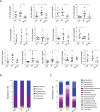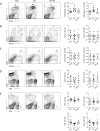Small intestinal immune-environmental changes induced by oral tolerance inhibit experimental atopic dermatitis
- PMID: 33664229
- PMCID: PMC7933185
- DOI: 10.1038/s41419-021-03534-w
Small intestinal immune-environmental changes induced by oral tolerance inhibit experimental atopic dermatitis
Abstract
Atopic dermatitis is a chronic skin inflammatory disease mediated by Th2-type immune responses. Although intestinal immune responses have been shown to play a critical role in the development or prevention of atopic dermatitis, the precise influence of intestinal immunity on atopic dermatitis is incompletely understood. We show here that orally tolerized mice are protected from experimental atopic dermatitis induced by sensitization and epicutaneous (EC) challenge to ovalbumin. Although the expression of Th2-type cytokines in the small intestine of orally tolerized and EC-challenged mice did not change significantly, these mice showed decreased inflammatory responses in the small intestine with restoration of microbial change elicited by the EC challenge. Interestingly, an increase in small intestinal eosinophils was observed with the EC challenge, which was also inhibited by oral tolerance. The role of small intestinal eosinophils and microbiota in the pathogenesis of experimental atopic dermatitis was further substantiated by decreased inflammatory mediators in the small intestine and attenuated Th2-type inflammation in the skin of eosinophil-deficient and microbiota-ablated mice with EC challenges. Based on these data, we propose that the bidirectional interaction between the skin and the intestine has a role in the pathogenesis of atopic dermatitis and that modulation of the intestinal microenvironments could be a therapeutic approach to atopic dermatitis.
Conflict of interest statement
The authors declare no competing interests.
Figures






Similar articles
-
Oral tolerance inhibits atopic dermatitis-like type 2 inflammation in mice by modulating immune microenvironments.Allergy. 2017 Mar;72(3):397-406. doi: 10.1111/all.12960. Epub 2016 Jul 22. Allergy. 2017. PMID: 27325577
-
Oral tolerance modulates the skin transcriptome in mice with induced atopic dermatitis.Allergy. 2018 Apr;73(4):962-966. doi: 10.1111/all.13367. Epub 2017 Dec 12. Allergy. 2018. PMID: 29168893
-
Fecal microbiota transplantation as a new way for OVA-induced atopic dermatitis of juvenile mice.Int Immunopharmacol. 2024 Dec 5;142(Pt B):113183. doi: 10.1016/j.intimp.2024.113183. Epub 2024 Sep 18. Int Immunopharmacol. 2024. PMID: 39298815
-
Skin Microbiome in Atopic Dermatitis.Acta Derm Venereol. 2020 Jun 9;100(12):adv00164. doi: 10.2340/00015555-3514. Acta Derm Venereol. 2020. PMID: 32419029 Free PMC article. Review.
-
Outstanding animal studies in allergy II. From atopic barrier and microbiome to allergen-specific immunotherapy.Curr Opin Allergy Clin Immunol. 2017 Jun;17(3):180-187. doi: 10.1097/ACI.0000000000000364. Curr Opin Allergy Clin Immunol. 2017. PMID: 28375932 Free PMC article. Review.
Cited by
-
Antarctic Marine Algae Extracts as a Potential Natural Resource to Protect Epithelial Barrier Integrity.Mar Drugs. 2022 Aug 31;20(9):562. doi: 10.3390/md20090562. Mar Drugs. 2022. PMID: 36135751 Free PMC article.
-
Polygenic transcriptome risk scores enhance predictive accuracy in atopic dermatitis.J Transl Med. 2025 May 23;23(1):575. doi: 10.1186/s12967-025-06570-8. J Transl Med. 2025. PMID: 40410830 Free PMC article.
-
Allergens in Atopic Dermatitis.Clin Rev Allergy Immunol. 2025 Feb 10;68(1):11. doi: 10.1007/s12016-025-09024-7. Clin Rev Allergy Immunol. 2025. PMID: 39924626 Review.
-
Oxidative Stress and Gut Microbiome in Inflammatory Skin Diseases.Front Cell Dev Biol. 2022 Mar 7;10:849985. doi: 10.3389/fcell.2022.849985. eCollection 2022. Front Cell Dev Biol. 2022. PMID: 35321240 Free PMC article. Review.
-
Differential pathological changes in colon microenvironments in acute and chronic mouse models of inflammatory bowel disease.Anim Cells Syst (Seoul). 2025 Jan 18;29(1):100-112. doi: 10.1080/19768354.2025.2451408. eCollection 2025. Anim Cells Syst (Seoul). 2025. PMID: 39839656 Free PMC article.
References
MeSH terms
Substances
LinkOut - more resources
Full Text Sources
Other Literature Sources
Molecular Biology Databases

